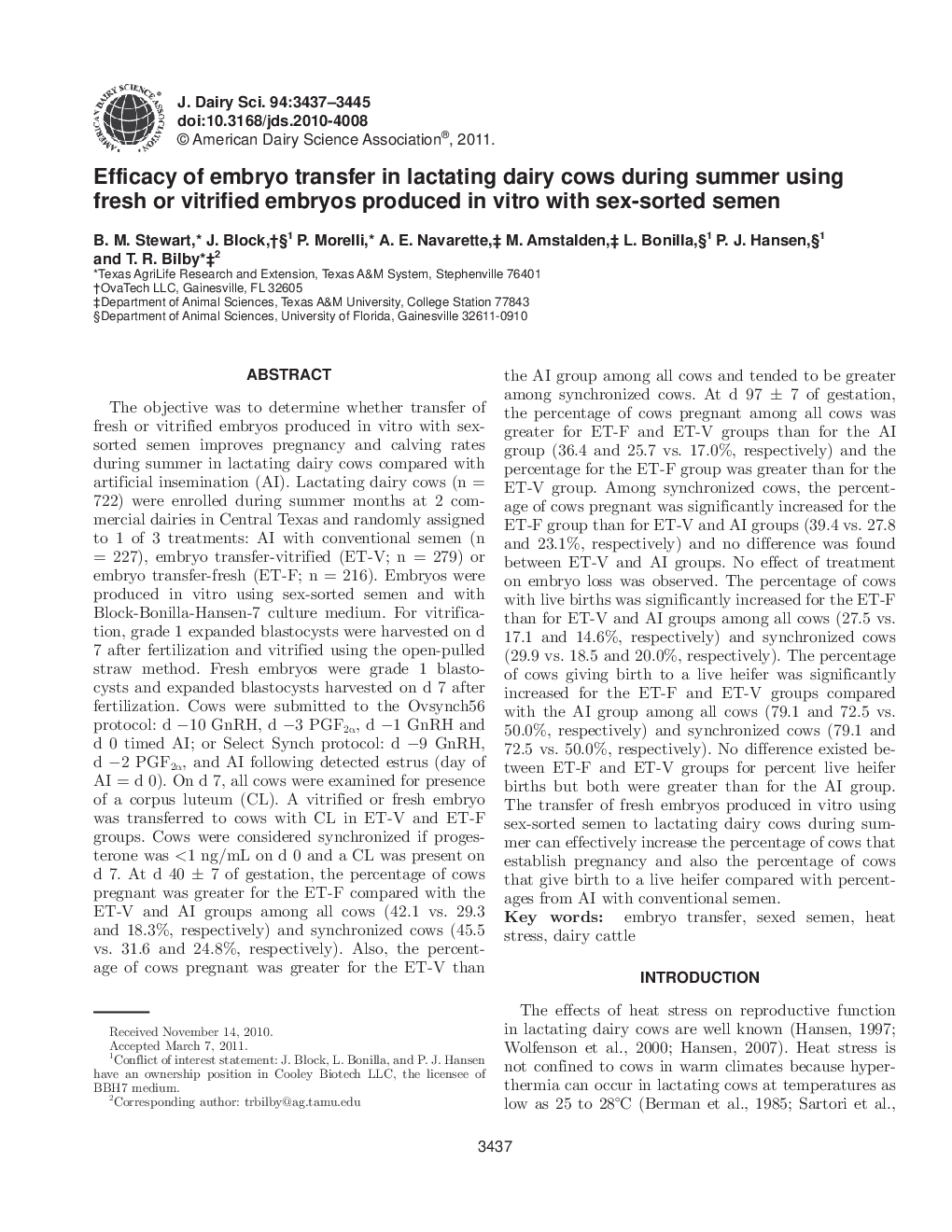| کد مقاله | کد نشریه | سال انتشار | مقاله انگلیسی | نسخه تمام متن |
|---|---|---|---|---|
| 10979351 | 1108063 | 2011 | 9 صفحه PDF | دانلود رایگان |
عنوان انگلیسی مقاله ISI
Efficacy of embryo transfer in lactating dairy cows during summer using fresh or vitrified embryos produced in vitro with sex-sorted semen
دانلود مقاله + سفارش ترجمه
دانلود مقاله ISI انگلیسی
رایگان برای ایرانیان
کلمات کلیدی
موضوعات مرتبط
علوم زیستی و بیوفناوری
علوم کشاورزی و بیولوژیک
علوم دامی و جانورشناسی
پیش نمایش صفحه اول مقاله

چکیده انگلیسی
The objective was to determine whether transfer of fresh or vitrified embryos produced in vitro with sex-sorted semen improves pregnancy and calving rates during summer in lactating dairy cows compared with artificial insemination (AI). Lactating dairy cows (n = 722) were enrolled during summer months at 2 commercial dairies in Central Texas and randomly assigned to 1 of 3 treatments: AI with conventional semen (n = 227), embryo transfer-vitrified (ET-V; n = 279) or embryo transfer-fresh (ET-F; n = 216). Embryos were produced in vitro using sex-sorted semen and with Block-Bonilla-Hansen-7 culture medium. For vitrification, grade 1 expanded blastocysts were harvested on d 7 after fertilization and vitrified using the open-pulled straw method. Fresh embryos were grade 1 blastocysts and expanded blastocysts harvested on d 7 after fertilization. Cows were submitted to the Ovsynch56 protocol: d â10 GnRH, d â3 PGF2α, d â1 GnRH and d 0 timed AI; or Select Synch protocol: d â9 GnRH, d â2 PGF2α, and AI following detected estrus (day of AI = d 0). On d 7, all cows were examined for presence of a corpus luteum (CL). A vitrified or fresh embryo was transferred to cows with CL in ET-V and ET-F groups. Cows were considered synchronized if progesterone was <1 ng/mL on d 0 and a CL was present on d 7. At d 40 ± 7 of gestation, the percentage of cows pregnant was greater for the ET-F compared with the ET-V and AI groups among all cows (42.1 vs. 29.3 and 18.3%, respectively) and synchronized cows (45.5 vs. 31.6 and 24.8%, respectively). Also, the percentage of cows pregnant was greater for the ET-V than the AI group among all cows and tended to be greater among synchronized cows. At d 97 ± 7 of gestation, the percentage of cows pregnant among all cows was greater for ET-F and ET-V groups than for the AI group (36.4 and 25.7 vs. 17.0%, respectively) and the percentage for the ET-F group was greater than for the ET-V group. Among synchronized cows, the percentage of cows pregnant was significantly increased for the ET-F group than for ET-V and AI groups (39.4 vs. 27.8 and 23.1%, respectively) and no difference was found between ET-V and AI groups. No effect of treatment on embryo loss was observed. The percentage of cows with live births was significantly increased for the ET-F than for ET-V and AI groups among all cows (27.5 vs. 17.1 and 14.6%, respectively) and synchronized cows (29.9 vs. 18.5 and 20.0%, respectively). The percentage of cows giving birth to a live heifer was significantly increased for the ET-F and ET-V groups compared with the AI group among all cows (79.1 and 72.5 vs. 50.0%, respectively) and synchronized cows (79.1 and 72.5 vs. 50.0%, respectively). No difference existed between ET-F and ET-V groups for percent live heifer births but both were greater than for the AI group. The transfer of fresh embryos produced in vitro using sex-sorted semen to lactating dairy cows during summer can effectively increase the percentage of cows that establish pregnancy and also the percentage of cows that give birth to a live heifer compared with percentages from AI with conventional semen.
ناشر
Database: Elsevier - ScienceDirect (ساینس دایرکت)
Journal: Journal of Dairy Science - Volume 94, Issue 7, July 2011, Pages 3437-3445
Journal: Journal of Dairy Science - Volume 94, Issue 7, July 2011, Pages 3437-3445
نویسندگان
B.M. Stewart, J. Block, P. Morelli, A.E. Navarette, M. Amstalden, L. Bonilla, P.J. Hansen, T.R. Bilby,